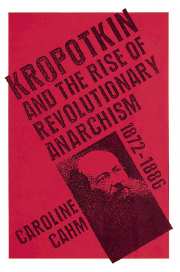Caroline Cahm: Kropotkin. And the Rise of Revolutionary Anarchism, 1872-1886 (2002)
Filed under book | Tags: · 1870s, 1880s, anarchism, communism, politics, revolution, socialism

This major study of Peter Kropotkin sets him firmly in the context of the development of the European anarchist movement as the man who became, after Bakunin’s death, their chief exponent of anarchist ideas. It traces the origins and development of his ideas and revolutionary practice from 1872 to 1886, and assesses the subsequent influence of his life and work upon European radical and socialist movements. Dr Cahm analyses Kropotkin’s role in the transformation of Bakunin’s anti-authoritarian socialism, and shows how two principal types of revolutionary action emerge from anarchist efforts to develop clear alternatives to the parliamentary strategies of social democrats; one based on the activity of individuals and small groups, the other related to large-scale collective action.
Publisher Cambridge University Press, 2002
ISBN 0521891574, 9780521891578
388 pages
Andreas Huyssen: After the Great Divide: Modernism, Mass Culture, Postmodernism (1986)
Filed under book | Tags: · aesthetics, avant-garde, culture industry, fascism, high modernism, mass culture, modernism, pop art, postmodernism, poststructuralism

Huyssen argues that postmodernism cannot be regarded as a radical break with the past, as it is deeply indebted to that other trend within the culture of modernity—the historical avant-garde.
Publisher Indiana University Press, 1986
Theories of representation and difference
ISBN 0253203996, 9780253203991
244 pages
PDF (no OCR; updated on 2012-7-18)
Comment (1)Stephen C. Foster (ed.): Hans Richter. Activism, Modernism, and the Avant-Garde (1998)
Filed under book | Tags: · abstract cinema, activism, art, art history, avant-garde, cinema

Few artists spanned the movements of early twentieth-century art as completely as did Hans Richter. Richter was a major force in the developments of expressionism, Dada, De Stijl, constructivism, and Surrealism, and the creator, with Viking Eggeling, of the abstract cinema. Along with Theo van Doesburg, László Moholy-Nagy, El Lissitzky, and a few others, he is one of the artists crucial to an understanding of the role of the arts in the reconstruction era following World War I.
Most American scholars have focused on Richter’s film work and have favored a strictly formalist approach that separates art and politics. The contributors to this book rewrite Richter’s history to include his pivotal role in the development of the early twentieth-century avant-garde and his political activism. When Richter’s work, particularly that of his earlier, European career, is viewed in its historical and political context, he emerges as an artist committed to the power of art to change the fabric of social, political, and cultural affairs.
Publisher The MIT Press, 1998
in collaboration with the University of Iowa Museum of Art, Iowa City
ISBN: 0262561298, 9780262561297
PDF (updated on 2012-7-31)
Comment (0)
